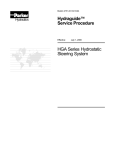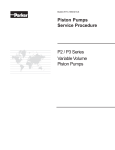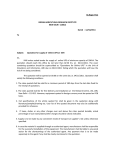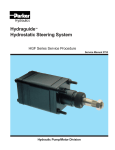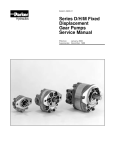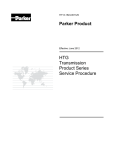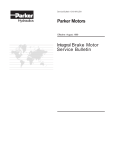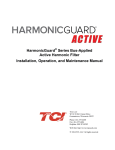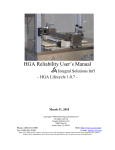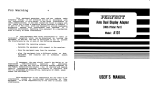Download Hydraguide™ Hydrostatic Steering System
Transcript
Hydraulics Hydraguide™ Hydrostatic Steering System HGA Service Manual Service Manual 2751 Hydraulic Pump/Motor Division TYPICAL OIL FLOW Table of Contents Section I System Operation .................................................................................................................page 3 Design and Function.............................................................................................................page 3 Control Valve ........................................................................................................................page 4 Metering Section...................................................................................................................page 4 Rotor Operation ....................................................................................................................page 4 Power Steering Operation ....................................................................................................page 5 Manual Steering Operation...................................................................................................page 5 Exploded View ......................................................................................................................page 6 Service Parts List..................................................................................................................page 7 Section II Service Procedure ................................................................................................................page 8 Work Conditions ...................................................................................................................page 8 Exploded View ......................................................................................................................page 7 Seal Replacement Instructions .............................................................................................page 9 Servicing of HGA Unit...........................................................................................................page 9 Disassembly Procedure......................................................................................................page 10 Section III Inspection and Replacement ..............................................................................................page 13 Section IV Assembly Procedure...........................................................................................................page 14 Column Assembly and Disassembly Procedures ...............................................................page 18 Filling and Air Bleeding System ..........................................................................................page 19 Hydraulic Fluid ....................................................................................................................page 19 Tips for Maintaining the System .........................................................................................page 20 ! WARNING FAILURE OR IMPROPER SELECTION OF IMPROPER USE OF THE PRODUCTS AND/OR SYSTEMS DESCRIBED HEREIN OR RELATED ITEMS CAN CAUSE DEATH, PERSONAL INJURY AND PROPERTY DAMAGE. This document and other information from Ross Operation, its subsidiaries and authorized distributors provide product and/or system options for further investigation by users having technical expertise. It is important that you analyze all aspects of your application and review the information concerning the product or system in the current product catalog. Due to the variety of operating conditions and applications for these products or systems, the user, through its own analysis is and testing, is solely responsible for making the final selection of the products and systems and assuring that all performance, safety and warning requirements of the application are met. The products described herein, including without limitation, product features, specifications, designs, availability and pricing, are subject to change by Ross Operation and its subsidiaries at any time without notice. HYDRAGUIDE™ STEERING MODEL HGA For over half a century, Ross has anticipated and met the changing and increasing needs for better steering of automotive, construction, industrial and agricultural machines. This hydrostatic steering system described herein is further evidence of this fact. Hydraguide™ is the Ross name given to hydrostatic steering systems. In the HGA type Hydraguide™ steering system, an engine-driven pump, relief valve, cylinder, reservoir, filter, fluid lines, and an HGA control unit are needed. An automotive type steering wheel is attached to the HGA unit and the cylinder is connected by suitable means to the steered wheels. The driver has power steering control at all times, so long as system components work together, system integrity is maintained, and adequate fluid is present. If there is a failure in the high-pressure circuit, a loss of power steering will result. The HGA, however, is designed to have some manual steering capability, depending on the installation. If you can’t manually steer the vehicle without using extraordinary measures, such as leaving your seat, or pushing with your legs, don’t try it. Repair the failure in the power circuit. Some vehicles may be impossible to steer manually because of their weight and size. WARNING: EXTRAORDINARY MEASURES SHOULD NOT BE USED IN ATTEMPTING TO MANUALLY STEER THE VEHICLE, AS THEY MAY GENERATE FORCES IN EXCESS OF 125 FT. LBS., THEREBY DAMAGING THE UNIT INTERNALLY, WHICH COULD RESULT IN A COMPLETE LOSS OF STEERING. WARNING: ALL STEERING MECHANISMS ARE LIFE AND LIMB ITEMS. AS SUCH, IT IS IMPERATIVE THAT THE INSTRUCTIONS IN THIS BOOKLET ARE FOLLOWED TO THE LETTER. FAILURE TO OBSERVE THE PROCEDURES SET OUT IN THIS PAMPHLET MAY RESULT IN LOSS OF STEERING. 2 SECTION I A. SYSTEM OPERATION This literature with the illustrations shown covers a standard basic design of the HGA unit. Variations may be engineered to suit special requirements. The description of the operation of the HGA unit and the illustrations explain the functioning of the system for the utilization of the hydraulic power generated by the engine-driven pump for power steering. The functioning of the system for manual operation is also described. Satisfactory performance of this system requires a well engineered installation designed for the particular type of vehicle and the type and kind of service for which it will be used. Ross Engineering advice and assistance is available and we welcome requests. Information on the required engine-driven pump capacity and the power cylinder size and connecting lines are provided through engineering contacts. A balanced cylinder design is preferred. Figure HGA-1 B. DESIGN & FUNCTION The HGA unit consists of a fluid control valve sec- tion and a fluid metering section which are hydraulically and mechanically inter-connected. 3 C. CONTROL VALVE The control valve section contains a mechanically actuated linear spool which is torsion bar centered. The function of the control valve section is to direct the fluid to and from the metering section, to and from the cylinder, and to regulate the pressure supplied to the cylinder. The valve is provided with unique pressure chambers which insure effective circuit isolation. D. METERING SECTION The metering section consists of a commutator and bi-directional gerotor element, which contains an orbiting rotor and a fixed stator. The commutator rotates at orbit speed with the rotor and channels the fluid to and from the rotor set and the valve section. The rotor incorporates unique sealing vanes which are spring and hydraulically forced into sealing contact between the rotor and stator to reduce leakage across the metering section. The function of the metering section is to meter the oil to the power cylinder, maintaining the relationship between the hand wheel and the steered wheels. An additional function of the metering section is to act as a manually operated pump providing manual steering in the event of an inoperative engine-driven pump. Figure HGA-2 E. ROTOR OPERATION IN THE ROTOR SET (See Fig. HGA-3) Each lobe of the rotor has a diametrically opposite lobe, therefore, when one lobe is in a cavity its opposite lobe is at the crest of the stator’s convex form opposite the cavity. As the rotor is rotated, each lobe in sequence is moved out of its cavity to the crest of the stator’s convex form and this forces each opposite lobe, in sequence, into a cavity. Due to the inter- action between the rotor and the stator, there are 42 fluid discharging actions in one revolution of the rotor. When the rotor is moving, fluid is always flowing out of three of the cavities while fluid is flowing into three other cavities, and one of the cavities is inactive as it changes from one of discharging fluid to one of admitting fluid. The commutator rotates with the rotor and channels the fluid from and to the valve section, and to and from the rotor set. Figure HGA-3 4 F. POWER STEERING OPERATION When the spool is in center or neutral position, the hydraulic oil from the engine-driven pump circulates through the valve section, directly back to the reservoir with sufficient pressure only to overcome friction of valve channels and lines. There is no circulation of engine-driven pump oil to or from the cylinder. Note the center diagram showing neutral position (See diagram on inside front cover) on which no directional arrows appear in the metering channels. The oil pressure at the two cylinder ports is equal and produces ineffective forces in the cylinder. In order to accomplish a power steering maneuver, the operator must rotate the steering wheel in the direction of the steering maneuver. The initial rotation of the steering wheel rotates the input shaft which tends to rotate the drive link and rotor set through the torsion bar centering spring. Rotation of the rotor set and spool which are coupled by the drive link, is resisted by the cylinder pressure required to overcome the steering forces. As the input shaft is rotated relative to the spool, the centering spring is torsionally deflected. Axial shift of the spool is inducted by the ball which is captive in the spool and engaged in the helical groove provided in the input shaft. When the spool is axially displaced within the body, fluid channels are selected connecting the enginedriven pump to the intake side of the rotor set via the commutator. The exhaust side of the rotor set is connected, through the commutator, to one side of the cylinder while the other side of the cylinder is connected to the reservoir. (See Figures HGA-1 and 2). Further axial displacement of the spool results in increased system pressure to provide the level of pressure required. A portion or all of the hydraulic fluid at the required pressure from the engine-driven pump, depending upon the speed of steering, is directed to the cylinder via the metering section, using cylinder movement to accomplish the steering maneuver. G. MANUAL STEERING OPERATION In the absence of system pressure, the driver's manual effort displaces the spool axially. When the spool is displaced within the body, fluid channels are selected connecting the rotor set, which is now acting as a pump, via the commutator to one side of the cylinder. The return flow from the other side of the cylinder is channeled through a recirculation valve so that the oil will flow to the intake side of the rotor set via the commutator instead of back to the reservoir. (See. Figure HGA-5) The recirculation valve is a ball check valve in a channel connecting the return flow chamber to the engine-driven pump pressure inlet chamber. The recirculation valve is closed during power operation. WARNING: ALL STEERING MECHANISMS ARE LIFE AND LIMB ITEMS. AS SUCH, IT IS IMPERATIVE THAT THE INSTRUCTIONS IN THIS BOOKLET ARE FOLLOWED TO THE LETTER. FAILURE TO OBSERVE THE PROCEDURES SET OUT IN THIS PAMPLET MAY RESULT IN LOSS OF STEERING. 5 6 26. 27. 28. 29. 30. 31. 1. 2. 3. 4. 5. 6. 7. 8. 9. 10. Nut Seal Retaining Ring Backup Washer Seal Screw Upper Cover Seal Shim Retaining Ring 11. 12. 13. 14. 15. 16. 17. 18. 19. 20. Thrust Washer Thrust Bearing Thrust Washer Spring Washer Spacer Input Shaft Needle Roller Drive Ring Spacer Torsion Bar 21. 22. 23. 24. 25. Needle Roller Spoo Ball Spring Housing Assembly 25 a. Plug 25 b. “O” Ring 25 c. Balll Figure HGA-6 Ball “O” Ring Plug Spacer Drive Link Rotor Set 31 a. Stator 31 b. Rotor 31 c. Spring 31 d. Vane 32. 33. 34. 35. 36. 37. 38. 39. Man ifold Commutator Ring Commutator Seal Retainer Seal Washer End Cover Special Boplt USE WITH HGA SERVICE MANUAL EXPLODED VIEW 1 Wheel Nut 2, 4, & 5 Seal Kit 3 Snap Ring 6 Screw (4 ea.) 7 Upper Cover 8 Seal 9 Shim Kit 10 Snap Ring 11 Thrust Washer 026045 HG500007 401233 021434 HGA016005X1 032840X1 033157-X2 401367 400100 12 Thrust Bearing 13 Thrust Washer 14 Spring Bearing 15 Spacer Washer 16 Pinhole Washer 16 Wheel Mount Shaft 16 Fully 17 Needle Roller 18 Drive Ring 23 Ball 5/16” dia. 063979 400075 401366 477277 089181 089180 089193 040114 HGA013003 400013 24 Spring 25-A&B Plug & “O” Ring 25C & 26 Ball 1/4 dia. 27 & 28 Plug Assy. 29 Spacer 32 Manifold 32 & 34 Commutator Assy. 37 Washer 38 End Cover 401412 036147-X1 G453570 415395-A2 477235 HGA015001 HGA014000-A1 028395 402803-A1 22 & 25 Housing & spool are non-serviceable due to select fit if either needs replaced the entire unit must be replaced. STANDARD PARTS THAT CHANGE WITH DISPLACEMENT * Series 31C/D Vane Kit 31 Rotor Set 35 Seal Retainer 36 Seal HGA 07 HGA 08 HGA10 HGA 12 HGA 14 HGA 16 HGA 20 HGA 24 HGA 28 HGA 32 506608 506607 506606 506611 506610 506609 ——— ——— ——— ——— HGA077010 HGA087010 HGA107010 HGA127007 HGA147005 HGA167005 HGA207005 HGA247005 HGA287005 HGA327004 099069 099070 099071 099072 099073 099074 099075 099076 099077 099095 032625 032626 032618 032619 032627 032628 032620 032629 032621 032759 39 Bolts (7 ea.) Before Date After Date Code195-94 Code195-94 021269 021428 021269 021428 021280 021356 021283 021311 021290 021306 021292 021382 021294 021357 021295 021307 021296 021358 021349 021435 20 & 21 Torsion Bar** 30 Drive Link 19 Spacer BASE-A1-506 BASE-A1-506 BASE-A1-525 BASE-A1-538 BASE-A1-550 BASE-A1-562 BASE-A1-525 BASE-A1-550 BASE-A1-538 BASE-A1-562 HGA013008 HGA013008 HGA013008 HGA013008 HGA013008 HGA013008 HGA013005 HGA013005 HGA013006 HGA013006 477248-178 477248-184 477248-196 477248-209 477248-221 477248-234 477248-196 477248-221 477248-209 477248-234 Use part number 020206 on assemblies manufactured prior to date code 195-94 ** Torsion bars are unit specific. To select the correct replacement, measure the diameter of the center section of the bar and the length between holes, then select the correct base number from the following chart: 7 Base Number 401360 401363 401368 401413 401432 401435 401627 Bar Center Diameter - in. 0.147 0.160 0.160 0.154 0.147 0.139 0.139 Length Between Holes - in. 5.00 - 5.62 6.00 - 6.50 5.00 - 5.62 5.00 - 5.62 6.00 - 6.50 5.00 - 5.62 6.00 this power steering system is absolutely necessary. SECTION II SERVICE PROCEDURE For service information on the steering pump (engine-driven) and power cylinder, see information provided by the manufacturer of these units. For servicing the HGA unit and the system, see instructions in the following sections. If it is necessary to disassemble any of the units, make sure that a clean work bench or table is used. (A piece of clean wrapping paper makes an excellent disposable top). Outside dirt should be cleaned off before disconnecting lines and port holes should be plugged immediately after disconnecting lines. Servicing of HGA Unit Page 9 Finish cleaning off outside dirt before placing on work bench. Filling and Air Bleeding the System When Drained of Oil Page 19 Hydraulic Fluid Page 19 When disassembled, parts should be cleaned only in clear-clean petroleum base solvent and blown dry with clean, dry air. Other solvents may cause deterioration of rubber seals. Avoid wiping parts with cloth and never steam clean hydraulic steering assemblies. CLEAN WORK CONDITIONS It is a must that the system be kept free of dirt or foreign matter in the oil circuit. Cleanliness in serving WARNING: SINCE SOLVENTS ARE FLAMMABLE, BE EXTREMELY CAREFUL WHEN USING THEM. EVEN A SMALL EXPLOSION OR FIRE COULD CAUSE DEATH OR INJURY. WARNING: EYE PROTECTION SHOULD BE WORN. 8 WARNING: OSHA MAXIMUM AIR PRESSURE REQUIREMENTS SHOULD BE COMPLIED WITH TO PREVENT INJURY. SEAL REPLACEMENT INSTRUCTIONS For numerous installation you may want to purchase the J26910 tool kit available from KENT MOORE TOOL DIVISION, 29784 Little Mack, Roseville, Michigan 48066 - Phone (800) 345-2233. Caution: Follow the Instruction and do not disassemble the Hydraguide unit upper cover (7) to replace the shaft seal (5). rag. Caution: excessive particles of felt or lint can cause the new seal package to leak. 6. Cover the end of the Hydraguide unit input shaft with cellophane tape to protect the new seal (5) when it is assembled over the sharp edges of the input shaft. 7. Lubricate the new seal using hydraulic oil and install the new seal (5) with lip side first, onto the Hydraguide unit input shaft. 1. Remove the steering wheel nut (1), steering wheel and steering wheel column, if applicable. Refer to page 18 for instructions on removal of steering wheel column. 2. Remove the dirt seal (2) over the end of the Hydraguide unit upper cover, if applicable. Discard this part. 3. Remove the retaining ring (3), do not discard, this part must be reinstalled during assembly procedure. 4. Remove the seal package parts (4) (5) from the Hydraguide unit by one of the following methods: a) If the Hydraguide unit has not been removed from the vehicle, rotate the Hydraguide unit input shaft either clockwise or counter clockwise to pressurize the system and force the seal package out. Discard these parts. 8. Remove the cellophane tape from the Hydraguide unit input shaft. 9. Assemble the new washer (4), with small end first, onto the Hydraguide unit input shaft and push the new washer and the new seal (5), previously installed, down into the Hydraguide unit upper cover. (A short piece of metal tubing 15/16 minimum I.D. x 1-3/16 maximum O.D. or a 7/8 deep well socket may be used to push these parts into place.) 10. Assemble the previously used retaining ring (3) onto the Hydraguide unit input shaft and down into the Hydraguide unit upper cover groove. Be sure the rounded edge of the retaining ring (3) is faced inward. 11. Assemble the new seal (2) onto the Hydraguide unit input shaft and down into the Hydraguide unit upper cover (7) counter bore. 12. Assemble the steering column, if applicable. b) If the Hydraguide unit has been removed from the vehicle plug three of the four ports in the Hydraguide unit and pressurize the other port with air pressure to force the seal package out. Discard these parts. 13. Assemble the steering wheel and wheel nut, torque the wheel nut to 35 ft. lbs. 5. Note: Clean the Hydraguide unit input shaft (16) and upper cover (7) seal bore to remove particles of dirt, felt, lint, etc. with a clean, lint-free SERVICING OF HGA UNIT Refer to exploded view, Figure HGA-6 for parts identification. The spool (22) and the housing (25), the commutator (34), and commutator ring (33), as well as the rotor (31B) and the stator (31A) are not separately replaceable because they are selectively fitted at the factory. If the spool or housing need replacement, the complete housing assembly must be replaced. If the commutator or the commutator ring need replacement, both must be replaced as a matched set. If the rotor or stator need replacement, the complete rotor set (31) must be replaced. The pin in the end cover is not separately replaceable. If the pin or end cover need replacement, the end cover and pin assembly (38) must be replaced. 9 DISASSEMBLY PROCEDURE Plug the four port holes and clean the exterior of the unit thoroughly. Then remove the plugs. 1. To prevent possible distortion or damage to unit if placed directly in vise, the following procedure should be used. Insert “o” ring tube fitting, with tube nut or fitting cap attached, into one of the four threaded ports in the housing. Clamp the fitting in a vise in a manner which will locate the seven end cover bolts in an upright position. (See Figure HGA-7). Figure HGA-8 ifold (32), by a sliding and lifting motion. Care should be used in the handling of this fragile component. 7. Remove the manifold (32) from the rotor set (31) by sliding and lifting motion. 8. Remove the rotor set (31), spacer (29) and drive link (30) as an assembly by grasping the spacer and removing the assembly with a sliding and lifting motion. (See Figure HGA-9). Figure HGA-7 2. Unscrew the seven special bolts (39) from the end cover (38). Note: Special care should be used in the following steps to insure protection of the ground and lapped faces of the components. Avoid scratching or nicking of finished surfaces. 3. Remove end cover (38) by bumping it sideways with a soft hammer to loosen it from the rotor seal (36) and seal retainer (35), and lift from unit. Caution: The washer (37) and commutator (34) may adhere to the end cover, and may be removed with the end cover. Do not attempt to remove pin because pin is press fit in the plate and is non-serviceable. (See Figure HGA-8). 4. Remove the rotor seal (36) and seal retainer (35) by bumping the can sideways with a soft hammer to loosen it from the housing and lift off the rotor seal and seal retainer. Discard the rotor seal. 5. If the wear washer (37) and commutator (34) were not removed with the end cover (38), remove these parts from the HGA unit. 6. 10 Remove the commutator ring (33) from the man- Figure HGA-9 9. Separate drive link (30) by sliding the rotor set (31) on the spacer (29), allowing the drive link teeth to clear the spacer hole. Remove drive link and separate rotor set from spacer. Use extreme caution to keep vanes (31D) and springs (31C) from falling out. When handling the rotor set, pressure should be applied to the rotor (31B) by gripping the rotor set between the fingers and urging the rotor into contact with the stator (31A). (See Figure HGA-10) Carefully protect against damage to side faces. Note: The rotor (31B) and the stator (31A) must be kept in a matched set. snap ring pliers. Discard seal (2). Remove and discard backup washer (4). Remove and discard seal (5). 17. Remove the retaining ring (10), thrust washer (11), thrust bearing (12), thrust washer (13) and spring washer (14) from input shaft (16). Note: Retaining ring is twisted design. Do not straighten ring. Figure HGA-10 10. Reverse the HGA unit in the vise to place the input shaft (16) in a vertical position. Using a prick or center punch, mark the upper cover flange (7) in relation to a similar mark placed on the port face of the housing (25) to facilitate reassembly. (See figure HGA-11). 18. Remove the needle roller (17) by using a pin punch of .125-inch max. diameter for a minimum of .625 length. The input shaft (16) should be placed on a block of wood (to avoid shaft damage) and the needle roller (21) removed by impact, using light hammer blows. (See Figure HGA-12). 19. Remove the torsion bar (20) and spacer (19) by inverting the spool assembly and allowing the parts to fall free. Do not remove needle roller (21) from torsion bar. (See Figure HGA-13). MARKS Figure HGA-11 11. Remove the four special cap screws (6) by using a 5/16-12 point socket. 12. Grasp the input shaft (16) and with a smooth upward motion, remove the input shaft (16), upper cover (7) and spool (22) assembly from the housing (25). Note: Avoid applying side forces to the spool which would cause binding of the closely fitted assembly. Never use excessive force to remove the spool from the housing. Figure HGA-12 13. Remove and discard seal (8). 14. Remove the upper cover (7) with shaft seal package (Items 2 thru 5) intact. Remove spacer item (15). 15. Remove shims (9) from either upper cover (7) cavity or from face of thrust washer (11). Count and record the number of shims to aid in reassembly of unit. 16. Remove seal (2), retaining ring (3), using proper Figure HGA-13 11 20. Remove the drive ring (18) by placing the end of the spool (22) on a table surface. Rotate the input shaft (16) to extremes of travel until the drive ring falls free. (See Figure HGA-14). 21. With the spool assembly in the same position as the step above, rotate the input shaft (16) in a clockwise direction until the actuator ball (23) disengages from the helical groove in the input shaft. Lift out input shaft. Caution: The actuator ball may fall free and care should be used to not lose it. 22. Do not remove the ball retainer spring (24) unless replacement is required. If necessary to remove this spring, discard the retainer (24) if moved. A screwdriver may be used to assist in the prying of the spring over the shoulder of the spool (22). Care must be used to avoid scratching or nicking of the spool outside diameter and control edges. (The following procedure is optional). 23. Return to the housing (25) which is mounted in the vise. Remove the plug and roll pin assembly (28). A steel ball is captivated by the plug and roll pin assembly. Care must be used to avoid the loss of the ball. Remove ball by shaking after housing is removed from the vise. Discard “O” ring (27). Figure HGA-14 12 This completes the disassembly of the HGA unit. SECTION III INSPECTION AND REPLACEMENT Visually inspect all parts and replace those parts which are not in good condition. The following finished surfaces should be inspected for abnormal wear, scoring or damage. 1. Housing (25) bore and ends. 2. Valve spool (22) outside diameter. Some burnishing due to use may be observed. 3. Valve spool (22) control edges. 4. Valve spool (22) splines. 5. Input shaft (16) seal area. Check for rust, pitting and excessive wear. Light circumferential polishing due to seal contact may be observed. 6. Input shaft (16) helical groove. Note the contact pattern created by the actuator ball (23). Surface should be free from pits chipping or surface break down. 7. Thrust bearing (12) and thrust washers (11) and (13). Inspect for pitting of rolls and faces of thrust washers. 8. Drive link (30) pin slot. Width of slot must not exceed .001 inch difference at any point in its length. 9. Drive link (30) teeth. of the end cover (38) and check for freedom of rotor rotation within the stator. The action of the spring loaded vanes may be observed during Figure HGA-15 rotation. The vanes should move freely in their slots, without bind, due to the forces of the springs. (See Figure HGA-15). Using a feeler gage, check the rotor (31B) to the stator (31A) clearance as shown in figure HGA-16. If there is more than a .007 inch clearance, the rotor set (31) must be replaced. Note: This applies to rotor sets with and without vanes. 10. Torsion bar and needle roller assembly (20). Difference in diameter of needle roller (21) should not exceed .001. The following parts may show a polish pattern due to the rotor action and the circular motion of the commutator. The sides of these components are ground and lapped and should be free from nicks, burrs and scoring. 1. Spacer (29). 2. Manifold (32). 3. Rotor (31). 4. Commutator (34) and Commutator Ring (33). Note: Thickness difference between commutator and commutator ring (33) shall not exceed .002 inch. 5. End cover and pin assembly (38). Note: The rotor set (31) requires special attention in handling to avoid nicks and scratching. It is recommended that the rotor (31B), stator (31A), vanes (31D) and springs (31C) be checked in the assembled condition. To inspect the rotor set, place the assembly face down on the lapped face Figure HGA-16 Carefully lift the rotor set assembly (31) from the end cover (38) and measure the thickness of the rotor (31B) and stator (31A). Thickness difference between the rotor and stator shall not exceed .002 inch. The internal splines in the rotor should not allow abnormal wear or damage. 13 SECTION IV ASSEMBLY PROCEDURE IMPORTANT; Before starting assembly, clean all parts with clean petroleum base solvent and air dry. Do not wipe dry with rags. Be sure all dried paint chips have been removed from edges of lapped surfaces. Unless otherwise indicated, DO NOT oil parts before assembly. 1. Insert ball (26) into its cavity in the housing. 2. Install new “o” ring (27) on plug and roll-pin assembly (28) and install in the housing (25) to 10-14 ft. lbs. torque. 3. Reclamp housing (25) in the vise as shown in Figure HGA-11. 4. Assemble thrust washer (13), thrust bearing (12) , thrust washer (11) and retaining ring (10) on input shaft (16). 5. If the retaining spring (24) has been removed, install a new retaining spring. The spring must fit tightly. 6. Insert actuator ball (23) into ball seat located inside spool (22). 7. Assemble wave spring washer (14) over thrust washer (13) and thrust bearing (12). Insert the input shaft (16) into the spool, engaging the helix and ball with a counter-clockwise motion. This operation is best done while holding the spool in a horizontal position. 8. Using the mid-section of the torsion bar (20) as a gage, insert the gage between the spool end and the thrust washer (13). (See Figure HGA17). This will position the spool in the necessary radial relationship with the input shaft spline teeth for assembly of drive ring (18). 9. Place the input shaft (16) and spool (22) assembly in a vertical position, with the shaft end on the table surface. Figure HGA-18 NOTE: Rotate the input shaft (16) out of the valve spool (22) until input shaft will no longer rotate. There will be a gap of approximately .350 between end of valve spool (22) and thrust washer (13) if the drive ring (18) is assembled properly. 10. Insert the drive ring (18) into the spool (22) end by visually aligning an internal space on the drive ring with a tooth on the input shaft (16) split, and allow the drive ring to drop to the limit of its travel. If the drive ring does not engage the input shaft spline, a slight rotation of the input shaft will allow the drive ring to become fully engaged. Remove torsion bar (20) gage. (See Figure HGA-18). CAUTION: The HGA will not function properly if the correct relationship of spool, drive ring and input shaft is not achieved. 11. Install spacer (19) over torsion bar and pin assembly (20) and insert the assembly into the spool (22) end. 12. Align the cross-hole in the torsion bar (20) with the cross-hole in the input shaft (16) and insert a .120 diameter pin punch to maintain alignment. 13. Insert the needle roller (17) into cross-hole in input shaft (16); and while retracting the pin punch, engage the pin in the torsion bar (20) cross-hole. 14. Initiate press of needle roller (17) into torsion bar (20) with a few light impacts. Press needle roller flush with outside diameter of input shaft (16) using a 1/2” drive socket of 11/16 size for supporting the input shaft. (See Figure HGA-19). With a few light impacts on a .120 diameter pin punch, drive needle roller (17) approximately 1/32 below the input shaft (16) O.D. (See Figure HGA-12). 14 Figure HGA-17 NOTE: If any of the input shaft (16), housing and spool, torsion bar or upper cover (7) have been replaced, the following procedure for checking and shim adjustment must be used. Figure HGA-19 15. Assemble spacer (15) over valve spool (22), against spring washer (14). If so constructed, the inside lip end of spacer must be toward the spring washer. Place assembly, spool end first, into housing (25). Caution: Avoid applying side forces to the spool which would cause binding of the closely fitted assembly. Note: If neither the input shaft (16) or upper cover (7) are replaced, the original shims (9) may be reused. However, if in the inspection of parts, damage is found to the shims, discard these shims and replace with new parts of equal thickness. 16a. Place shims on top of the thrust washer (11). Coat seal (8) with clean grease and place in upper cover (7) counterbore. Assemble upper cover onto input shaft (16) and rotate to align punch marks previously made during disassembly. Note: If a new upper cover is used no angular orientation is required. However, it is necessary to align the upper cover (7) and housing (25). Replace without screws, finger tight, and then use a pilot ring or a worm drive type hose clamp tightened around the upper cover flange and the body pilot diameter to achieve the required alignment. Now tighten screws to 18-22 ft. lbs. torque. (See Figure HGA-20). 16b. Re-assemble as in “a” above using the required new parts. After torquing the four screws (6) revolve unit in vise so that the input shaft is pointing downward. In order to determine that the unit is shimmed correctly, the drive link (30) must be in in its proper position. To do this, grasp the input shaft (16), pull downward, and prevent rotation. Engage drive link splines in spool (22) and rotate to position spool essentially flush with end of housing (25). Remove drive link and orient drive link slot to engage torsion bar needle roller (21) and insert drive link. Observe relationship of spool end to body. The valve spool must protrude .020 ± .0025 from the adjacent counterbore surface. If within spec. no additional shimming required. If not within .0025, add or remove shims (9) until this requirement is satisfied repeating assembling steps as outlined in “a” above. (See Figure HGA-21). Figure HGA-21 16c. The correct shimming must be checked on the vehicle or on a suitable hydraulic test stand. The amount of steering effort required to steer the vehicle when the vehicle is at rest on dry pavement must be equal within two inch pounds. For example: if twenty-one inch pounds is required to steer to the right, not less than thirteen or more than twenty-three inch pounds should be required to steer to the left. If a test stand is available to place a load between cylinder ports in the same manner as on the vehicle, a test stand should be used. Add shims to increase steering efforts in a left turn, subtract shims to increase steering effort in a right turn. Figure HGA-20 17. With the drive link (30) installed as described above, assemble two assembly posts into the housing (25) as shown in Figure HGA-22. These 15 the heads off of two bolts similar to the special bolts (39). Figure HGA-24 Figure HGA-22 20. Install manifold (32) over assembly posts and onto rotor set (31), make sure circular slot side of manifold is up. (See Figure HGA-25). 18. Assemble spacer plate (29) over assembly posts and onto housing (25) with plain side up. (See Figure HGA-23). Figure HGA-25 Figure HGA-23 19. Install rotor set (31) over assembly posts and onto spacer plate (29). Note: One of the seven holes in the rotor set may be smaller than the other six holes. Position this hole, if applicable, over one of the assembly posts. (See Figure HGA-24). Warning: All vane springs (31C) must be down in their slots with no part of spring protruding out either side of metering element. 16 21. Install commutator ring (33) over assembly posts and onto manifold (32), make sure slot side is down. (See Figure HGA-26). 22. Install rotor seal (36) and seal retainer (35) over rotor set (31) and down against housing. 23. To allow for washer (37) assemble commutator (34) with counterbore up into commutator ring (33) with slotted hole in commutator engaging nose of drive link (30). Align commutator outside diameter concentric with inside diameter of commutator ring. (See Figure HGA-27). 2. Torque all seven special bolts to 15-19 ft. lbs. in sequence as shown in Figure HGA28. Note: Rotate input shaft during step 2 to prevent binding. Figure HGA-26 Figure HGA-28 27. Relocate HGA unit in a vise with the input shaft up. Cover end of input shaft with cellophane tape, to protect new seal (5) when it is assembled over sharp edges of input shaft. 28. Lubricate and install new seal (5) with lip side first onto input shaft. 29. Assemble new washer (4), with small end first, onto input shaft and push new washer and new seal down into upper cover (7). (A short piece of metal tubing, 15/16” minimum I.D. x 1-3/16” maximum O.D. or a 7/8” deep well socket may be used to push these parts into place.) 30. Assemble retaining ring (3) into upper cover (7) groove. Be sure rounded edge of retaining ring is faced inward. 31. Assemble new dirt seal (2) into upper cover (7) counterbore. 32. Note: If the HGA unit is to be stored, plug the cylinder ports and fill the inlet port with clean oil. Rotate input shaft until oil appears at outlet port. 33. Plug the port holes to prevent entrance of dirt. This completes assembly of the HGA unit. Figure HGA-27 24. Apply a small amount of clean grease to washer (37) and install over pin in end cover assembly (38). Grease should hold washer (37) to end cover assembly. 25. Assemble end cover assembly (38) with washer (37) attached over assembly posts and onto HGA unit. 26. Install five of the special bolts (39) finger tight. Remove two assembly posts and assemble the other two special bolts per steps 1 and 2 as follows, and do not over torque as it will cause unrepairable damage: 1. Torque all seven special bolts to 2-3 ft. lbs in sequence as shown in Figure HGA-28. 17 HGA COLUMN 1. 2. 3. 475109-A1 403813 401362 4. 5. 6. 040050 089142 096245 7. 8. 6. & 7. 063980 026045 096245-A1 TO DISASSEMBLE COLUMN TO ASSEMBLE COLUMN 1. Remove steering wheel and wheel nut (8). 1. Assemble the clamp assembly (1) onto the HGA unit. (Do not tighten.) 2. Loosen clamp assembly (1) on upper cover of HGA unit. If the application has a column support clamp, this clamp should be loosened at this time. 2. Assemble the coupling (2) and align pin hole. 3. If there is a horn contact assembly on the column, remove the 4 small screws from the metal cover (if applicable), and remove the metal cover and gasket. Remove the 2 small screws from the horn contact assembly. 4. Pull the jacket tube (6) and bearing assembly (7) off of the wheel tube (5). 5. Remove the retaining springs (3) and discard. 6. Lightly tap out the pins (4) with brass rods and hammer. Do not hit the pins with heavy hammer blows, as this may damage the needle bearing in the HGA unit. 7. Remove the wheel tube (5). 8. Remove the coupling (2). 9. Remove the clamp assembly (1). 18 3. Assemble one of the pins (4) and one of the new retaining rings (3). 4. Assemble the wheel tube (5) and align pin hole. 5. Assemble the other pin (4) and retaining ring (3). 6. Apply a small amount of clean grease to the inside of bearing assembly (7). 7. Assemble the jacket tube (6) and bearing assembly (7) over the wheel tube, through the clamp assembly (1) and onto the HGA unit upper cover. 8. Tighten the clamp assembly (1) bolt to 15-20 ft. lbs. 9. Assemble the steering wheel and tighten the wheel nut to 32.5 - 37.5 ft. lbs. 10. If the application has a column support clamp, it is extremely important that the jacket tube (6) align with this clamp in the free state. If misalignment is evident, the HGA unit must be shimmed at the mounting surface to eliminate the misalignment, or damage may result to the HGA unit. 11. If applicable, assemble the horn contact assembly, cover gasket and metal cover on the jacket tube (6). FILLING AND AIR BLEEDING THE SYSTEM WHEN DRAINED OF OIL 1. 2. Fill reservoir nearly full. Be ready to add oil when the engine is started. Do not let oil level drop below the inlet to the power pump so that the power pump will not suck air into the system. Start engine and let it idle. Immediately add oil to the reservoir as needed. HYDRAULIC FLUID Keep the steering system filled with one of the following: Automatic Transmission Fluid Type “F” Automatic Transmission Fluid Dexron II Hydraulic fluid as recommended by the vehicle manufacturer. NOTE: This oil will now be circulating only from the power pump to and through part of the HGA control valve and to the reservoir and back to the power pump. When no more oil can be added and oil is clear, proceed as follows. 3. With one finger on a spoke of the steering wheel, spin wheel as rapidly as possible to bleed the air in the steering cylinder(s) and lines. 4. Immediately upon HGA valve spool actuation oil must be added to the reservoir — to replenish the oil moving into the circuit. 5. Keep rotating the steering wheel to keep the HGA valve spool actuated. Do this until the road wheels have reached the stop in that direction, then quickly reverse the steering wheel rotation to actuate the HGA valve spool in the opposite direction. 6. Keep rotating the steering wheel left and right from stop to stop of the road wheels to bleed out air. Replenish oil as necessary. 7. The air will bleed out only at the reservoir, therefore, the oil must be circulated in both directions repeatedly until the air has bled out. WARNING: DO NOT MIX OIL TYPES, ANY MIXTURE, OR AN UNAPPROVED OIL, COULD DETERIORATE THE SEALS. ENOUGH FLUID COULD THEN LEAK TO CREATE A LOSS OF POWER STEERING ASSIST. DO NOT ALLOW FLUID LEVEL TO GO BELOW FILL LINE ON DIPSTICK. BEFORE ADDING NEW FLUID, COMPLETELY DRAIN OLD OIL FROM THE SYSTEM. IT MAY BE NECESSARY ALSO THAT YOU FLUSH THE SYSTEM WITH CLEAN OIL. NOTE: The oil in the lines to the power cylinder reaches a “dead end” at the piston. The oil in the cylinder does not flow in a circuit. As the piston moves back and forth the oil moves back and forth in the lines. Therefore, air in these lines and the cylinder may be slow moving into the HGA control valve and to the reservoir. CAUTION: Do not operate vehicle until air is bled out. 8. When the oil in the reservoir is clear (not cloudy or creamy), the system is free of air. (Slight creep or drift of the steering wheel is normal.) 9. Adjust the oil to recommended level in reservoir and assemble reservoir cover. 10. Always fill reservoir to recommended level. 19 TIPS FOR MAINTAINING THE HYDROSTATIC STEERING SYSTEM — Top up fluid level in reservoir as necessary. — Maintain correctly inflated tires. — Always use a puller to remove the steering wheel. Do not use a hammer, torch, or crow bar. — Investigate and correct immediately any play, rattle, shimmy, or other unusual occurrence in the steering system. — Remove cause of steering column misalignment. — Encourage all drivers or operators to report any malfunction or accident that may have damaged a steering system part. — Do not attempt to weld any broken steering component. Replace the component with origi- WARNING:DO NOT WELD, BRAZE, OR SOLDER ANY STEERING SYSTEM COMPONENT. WARNING: MAXIMUM OPERATING PRESSURE MUST NOT EXCEED VEHICLE MANUFACTURER”S RECOMMENDED PUMP PRESSURE CAPACITY. nal equipment only. — Do not cold straighten, hot straighten, or bend any steering part. — Prevent dirt or other foreign matter from entering the hydraulic system. Clean off around filler caps before checking oil level. — Investigate and correct any external leak in the steering system, no matter how minor the leak. — Comply with manufacturer’s specifications for cleaning or replacing the filter. WARNINGS for Proper Steering System Operation WARNING: ALWAYS CAREFULLY INSPECT ANY STEERING SYSTEM COMPONENT THAT MAY HAVE BEEN STRUCK OR DAMAGED DURING OPERATION OR IN AN ACCIDENT. REPLACE ANY COMPONENT THAT IS DAMAGED OR THAT IS QUESTIONABLE. Ross extends close technical cooperation and assistance. If steering problems occur which you cannot solve, please contact our Ross Field Service Department. Our phone number and address are on the back cover of this manual. 20 OIL FLOW (From Recirculating Valve) RETURN OIL (To Recirculating Valve) METERED OIL FLOW (To Cylinder) HGA Service Manual Ross Operation 2745 Snapps Ferry Road Greeneville, TN 37745 USA Tel: (423) 639-8151 Fax: (423) 787-2418 (Sales) 2500/1-96 BB
























